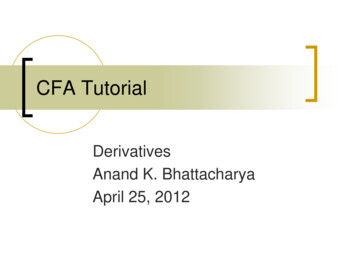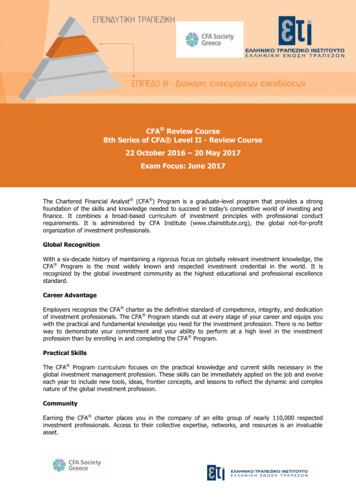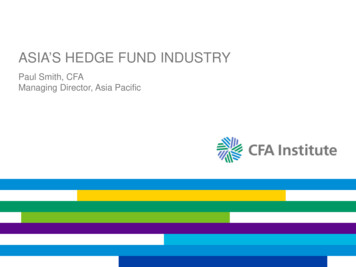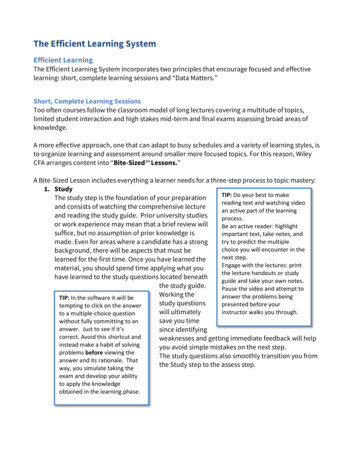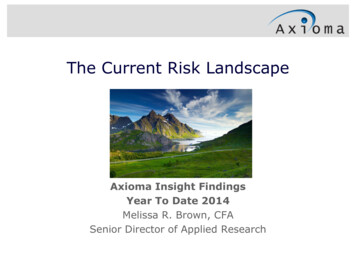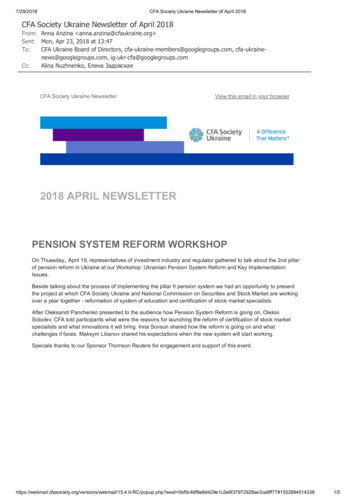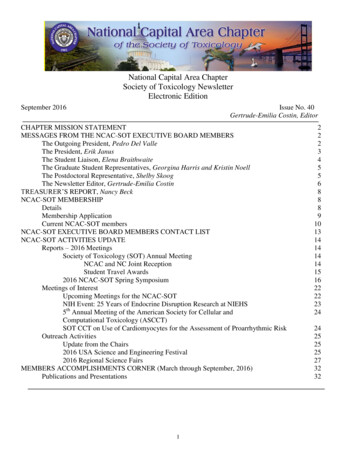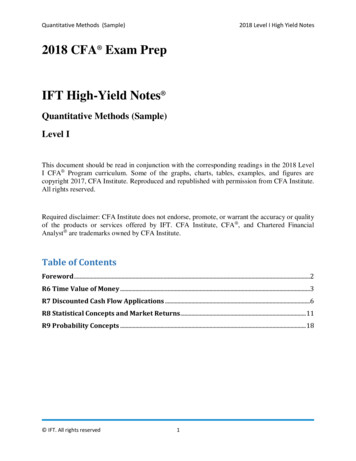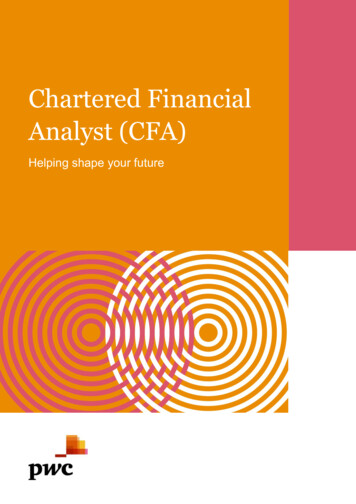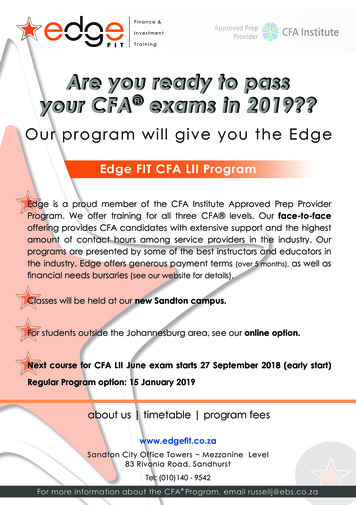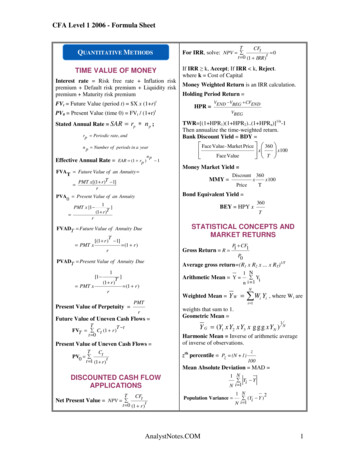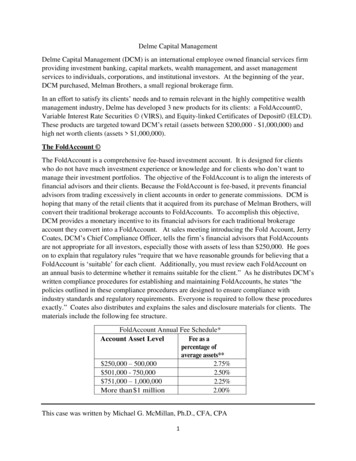
Transcription
Delme Capital ManagementDelme Capital Management (DCM) is an international employee owned financial services firmproviding investment banking, capital markets, wealth management, and asset managementservices to individuals, corporations, and institutional investors. At the beginning of the year,DCM purchased, Melman Brothers, a small regional brokerage firm.In an effort to satisfy its clients’ needs and to remain relevant in the highly competitive wealthmanagement industry, Delme has developed 3 new products for its clients: a FoldAccount ,Variable Interest Rate Securities (VIRS), and Equity-linked Certificates of Deposit (ELCD).These products are targeted toward DCM’s retail (assets between 200,000 - 1,000,000) andhigh net worth clients (assets 1,000,000).The FoldAccount The FoldAccount is a comprehensive fee-based investment account. It is designed for clientswho do not have much investment experience or knowledge and for clients who don’t want tomanage their investment portfolios. The objective of the FoldAccount is to align the interests offinancial advisors and their clients. Because the FoldAccount is fee-based, it prevents financialadvisors from trading excessively in client accounts in order to generate commissions. DCM ishoping that many of the retail clients that it acquired from its purchase of Melman Brothers, willconvert their traditional brokerage accounts to FoldAccounts. To accomplish this objective,DCM provides a monetary incentive to its financial advisors for each traditional brokerageaccount they convert into a FoldAccount. At sales meeting introducing the Fold Account, JerryCoates, DCM’s Chief Compliance Officer, tells the firm’s financial advisors that FoldAccountsare not appropriate for all investors, especially those with assets of less than 250,000. He goeson to explain that regulatory rules “require that we have reasonable grounds for believing that aFoldAccount is ‘suitable’ for each client. Additionally, you must review each FoldAccount onan annual basis to determine whether it remains suitable for the client.” As he distributes DCM’swritten compliance procedures for establishing and maintaining FoldAccounts, he states “thepolicies outlined in these compliance procedures are designed to ensure compliance withindustry standards and regulatory requirements. Everyone is required to follow these proceduresexactly.” Coates also distributes and explains the sales and disclosure materials for clients. Thematerials include the following fee structure.FoldAccount Annual Fee Schedule*Account Asset LevelFee as apercentage ofaverage assets** 250,000 – 500,0002.75% 501,000 - 750,0002.50% 751,000 – 1,000,0002.25%More than 1 million2.00%This case was written by Michael G. McMillan, Ph.D., CFA, CPA1
*Annual fees are billed quarterly based on average daily balance in theaccount during that quarter.** The annual fee includes all fees paid to the primary advisor, sub advisorsor mutual fund managers, plan sponsor, clearing and custody agentsCharlotte Johansen, CFA Level I candidate, is a registered representative andfinancial advisor with DCM. Johanson is very excited about the new FoldAccountbecause it will allow her to better serve her clients’ without having to worry aboutcommissions or profits. One client that she plans to talk to about the FoldAccount isVictor LeClerc. LeClerc’s account was given to Charlotte after DCM acquiredMelman Brothers. This morning Charlotte will be meeting with LeClerc to reviewhis Investment Policy Statement and to discuss strategic and tactical asset allocationplans.Charlotte: Victor it is a pleasure to meet you. Thank you so much for taking the timeto come to my office to discuss your portfolio.LeClerc: Charlotte, I am looking forward to getting some expert financial advice onmy portfolio. Since I am not very knowledgeable about investing, I have alwaysadopted a “buy and hold” strategy. As a result, I have not bought or sold anysecurities in the past five years. Instead, I have been living off of the income theportfolio generates.Charlotte: That’s great Victor. Tell me a little bit more about yourself and yourinvestment objectives.LeClerc: I am a 75-year old widower, who has had an investment account withMelman Brothers for almost 20 years. I have 4 children and 6 grandchildren. Mygoal is to continue to live off of the income that my portfolio generates, and thenbequeath what is left to my children when I die. I would classify myself as aconservative investor with hopefully, a long-term horizon!Charlotte: Victor, it looks like you are in good financial health. Currently, the valueof your portfolio is approximately 8 million and it generates approximately 100,000in annual dividend and interest income. However, it looks like your portfolio coulduse some additional diversification. One quarter of your portfolio is in governmentbonds, bond funds, and cash and the rest is in three stocks, Spector & Walsh, MBI,and ObHealthcare. Why do you only own three stocks?LeClerc: Those three stocks have sentimental value for me. Spector & Walsh wasmy long time employer, MBI was dearly departed wife’s employer, and my daughtercurrently works for ObHealthcare. I have owned most of these securities for morethan 20 years.Charlotte: To begin with Victor, I think that you should open a FoldAccount for yourinvestments because it has many advantages that your traditional brokerage account2
does not have. For example, with a FoldAccount both the cost of investment adviceand many implementation costs are “folded” into the annual fee that is billed on aquarterly basis. You can also buy or sell stocks, bonds, and other investment products(including those in which you are currently invested in) for no commissions ortransaction charges. As a result, the FoldAccount will give you access to the best,most successful money managers. You would not get this access in your traditionalbrokerage account. The FoldAccount also provides you with check writing capabilityand a money market account, so you can consolidate all of your savings and checkaccounts into one account.LeClerc: The FoldAccount sounds like a great idea. Although, I don’t do anytrading, I like having all of these individual fees include in one annual fee. I also likethe fact that once the percentage amount of the fee is set, it will remain the same foras long as I use DCM’s services.Charlotte: You are correct Victor, this is why the FoldAccount is perfect for you. Inaddition, to diversifying your portfolio, I recommend a more aggressive asset allocation. Iwould increase your allocation to equity securities and reduce your allocation to fixed incomesecurities because the current low interest rate environment is expected to continue for theforseeable future. To implement this strategy, I would sell some of your individual stocksand bonds and purchase “blue-chip” equity stock funds.LeClerc: Charlotte, since you are the expert, I will follow your advice.Charlotte and Victor continue to their discussion talk about his investment objectives,constraints, and time horizon. At the end of their meeting, LeClerc opens aFoldAccount and gives Charlotte permission to implement her proposeddiversification and asset allocation plan for his portfolio.Variable Interest Rate Securities (VIRS) DCM developed its Variable Rate Securities (VIRS) product for those investors seeking a cashlike investment that pays a higher yield than money market funds or certificates of deposits.VIRS are debt securities with maturities of 20 to 30 years, whose interest rates are reset every 28days through a Dutch auction. Unlike a traditional bond that is issued with a fixed interest ratefor the life of the bond, the interest rates on VIRS are variable because they are reset every 28days at the auction. VIRS are issued generally issued by corporations, municipalities, anduniversities. Before each action, current VIRS investors can request either to sell their VIRS, tohold their existing position at a specified interest rate, or to hold their VIRS at whatever newinterest is established by the auction. The size of any given auction is determined by how manycurrent VIRS investors to sell and how many want to hold at a certain minimum interest rate.Existing VIRS holders and potential purchases then indicate how much they wish to buy andwhat interest rate they are willing to accept. Bids, or buy orders with the lowest interest rate getaccepted first, followed by successively higher bids until all the securities available for auctionare sold. The highest interest rate accepted in the auction – the “clearing rate’ – then becomesthe interest rate that applies to all the VIRS until the next auction. Investors who bid a minimum3
rate above the clearing rate receive no bonds, while those whose minimum bid rates that were ator below the clearing rate receive the clearing rate for the next period.These auctions also provide the primary source of liquidity to VIRS investors who wish to selltheir investment. Thus, they can be viewed as ready source of cash.Natalie and Miguel Canova are clients of Charlotte Johansen. One of their primary investmentgoals is to finance their daughters (twins) college education. The Canova’s immigrated fromtheir “war torn” country 25 years ago and since then have been saving and investing wisely. Forthe Canova’s, funding their children’s education is not only a matter of principle but one ofpride. Currently, the majority of the Canova’s liquid assets are in money market accounts andcertificates of deposit which can be accessed almost as readily as cash. This is very important tothe Canova’s because they live on the interest income generated by their investments and couldneed the money at any time. Last week 675,000 of the Canova’s 5-year certificates of depositmatured. As a result, they have made an appointment with Charlotte to get her advice aboutwhat they should do.Charlotte: It is good to see you again Mr. and Mrs. Canova. How are the twins?The Canovas: The twins are doing great. They will be graduating from high school later thisyear and both are planning to attend very expensive Ivy League Universities in the Fall. As aresult, we expect to have large tuition bills in the very near future. What types of cash-likeproducts does DCM offer that we can invest the proceeds of our recently matured certificates ofdeposit?Charlotte: Based on your Investment Policy Statement, I recommend that you invest the 675,00from your matured certificates of deposits in DCM’s Variable Interest Rate Securities product.These can be viewed as short-term debt securities that yield a little more than money marketfunds. They can easily be sold on the date of the next auction which is never more than 28 daysaway.The Canovas: We have heard of VIRS before, but don’t know too much about them. Why is theinterest rate on these higher than comparable cash-like alternatives?Charlotte: Interest rates are higher because the maturity (redemption) date on these bonds is 30years from now. In addition, they are currently paying a maximum interest rate because therewas enough demand from investors at the last auction.The Canovas: Based on your explanation of VIRS and their yield, we would like to invest 675,000 in five separate VIRS issues.Equity-Certificate of Deposit In response to the continuing global low interest rate environment, DCM’s investment bankinggroup created an Equity-linked Certificate Deposit (ELCD) for its retail and high networthclients who are interested in generating more interest income. The ELCD is linked to the4
performance of the MSCI World Index. It has a five-year maturity, offers a guaranteedcumulative minimum return, and has a capped cumulative maximum return. The ELCD,however, does not simply track the MSCI World Index. Instead, its return is based on a seriesof 6-month options, so that the potential maximum return would be attained only if the MSCIWorld index rose by an amount exceeding a specified threshold, in each of the ten 6-monthperiods from the ELCD’s inception to its maturity.DCM’s investment banking group has back-tested and modelled the performance of the ELCDand has obtained the following results: Since the inception of the MSCI World Index (March 31, 1986), there have not beenten consecutive 6-month periods in which the index rose by at least the ELCD’sthreshold percentage.According to financial model-based estimates of the ELCD’s expected return, there isa 0.25% probability that the ELCD would achieve its potential maximum return, and a55% probability that the ELCD’s return would not exceed the guaranteed minimum.These and other results are contained in a confidential internal Production Evaluation Reportthat is available to DCM’s advisors and portfolio managers. This report provides guidanceabout the ELCD’s features and includes a disclaimer, part of which states that “it is notdirected at, and should not be relied upon, by individual clients.”Separate from the Product Evaluation Report, DCM’s sales department has produced a“glossy” ELCD Marketing Brochure. Jerry Coates, DCM’s Chief Compliance Officer,requires that this brochure be distributed when advisors and portfolio managers discuss theELCD with current and prospective clients. The front page of the brochure includes thefollowing statements, each printed in the same font, size, and color: Potential return based on the MSCI World Index.5 year fixed investment term.Guaranteed minimum return of 3.5% (gross) at maturity.Potential maximum return of 40% (gross) at maturity.Page 3 of the Marketing Brocure gives the following explanation of the potential maximumreturn: “The maximum return of 40% (gross) at maturity will be achieved only if thepercentage gain in the MSCI World Index is at least 5% for each and every one of theconsecutive 6-month periods to maturity.”The brochure also includes an illustrative table showing examples of possible gross returns onan investment of 10,000, assuming that the product is held to maturity. The table containsfour scenarios, each printed in the same font, size and color. The scenarios shown are: theguaranteed minimum return; two scenarios of intermediate returns; and the potentialmaximum return.Clarence Dunleavy, CFA, is portfolio manager in the Wealth Management Division of DCM.Dunleavy meets with Cora Masters one of his clients to discuss the ELCD.5
Clarence: “Cora, after reviewing your Investment Policy Statement, especially your need forincome, and your unwillingness to assume much risk, I think the ELCD would an appropriateinvestment for you.”After giving Masters the ELCD brochure, Dunleavy reviews with her the expected returncharacteristics that are displayed. However, he leaves the final decision about whether sheshould invest in the ELCD up to her.DCM Research DepartmentDeirdre Benson is the Director of Equity and Fixed Income Research at DCM. DCM stresses“top down” fundamental analysis and uses a team approach to investment management. Thefirm’s investment professionals, many of whom are CFA charterholders or candidates, attendweekly investment committee meetings. At the meetings, the analysts responsible for differentindustrial sectors present their research and recommendations. Following each presentation, theinvestment committee, consisting of senior portfolio managers, questions the analyst about therecommendation. If the majority of the committee agrees with the recommendation, therecommendation is approved and the stock is placed on a restricted list while the firm executesthe necessary trades.Benson, recently hired Damian Palato, CFA, a recent MBA graduate from a top university withexcellent quantitative analysis skills. On Palato’s first day at DCM, Bension assigns him researchresponsibility for a company that Benson used to analyze and cover. She provides Palato withher past research including all of her files and reports. Benson instructs Palato to report backwhen he has finished his research and is ready to submit his own research report on the company.Palato reads Benson’s old reports before studying the financial statements of the company and itscompetitors. Taking advantage of the quantitative analysis skills he learned in the CFA Program,Palato also conducts a detailed multi-factor analysis. Afterward, he produces a written “buy”recommendation using Benson’s old research reports as a guide for format and submits a draft toBenson for review.After reviewing his work, Benson states that she is not familiar with multi-factor analysis.Although she agrees with Palato’s “buy” recommendation, she instructs him to omit themultifactor analysis from the report. Palato attempts to defend his research methodology, but isinterrupted because Benson has to participate in a conference call. Palato follows Benson’sinstructions and removes all mention of the multi-factor analysis from the final report. Thefollowing day Benson presents the completed report at DCM’s weekly internal investmentcommittee meeting. Both her and Palato’s names are listed on the document. After Benson’sinitial presentation, the committee turns to Palato and asks about his research. Palato uses thisopportunity to mention the multi-factor analysis. The committee later votes in favor of therecommendation and congratulates Palato on his work.Because of his strong quantitative skills Palato is asked to take over management of the DCMSmall Capitalization Value Equity Fund. Palato develops a value stock selection model thatproduces highly favorable simulated performance results. As a result, he plans to employ this6
model when he begins managing the fund. Palato drafts a letter for distribution to allshareholders. In this letter, he discusses his approach to equity selection using the model. Heincludes both the actual and simulated performance of the DC Small Capitalization ValueEquity Fund (SCVEF ) for the past three years (Exhibit 1).Exhibit 1Delme Small Capitalization Value Equity FundYear123Average annualreturnStonebridge Fund(Simulated)8.72%1.85%16.55%9.04%Stonebridge Fund(Actual)6.23%-3.25%16.55%6.51%Palato, also writes in the letter, “Using the proprietary selection for the past three years, theDelme Small Capitalization Value Equity Fund would have earned an average annual return ofmore than 250 basis points in excess of the fund’s actual return. Based on these simulatedresults, I am confident that employing the model will yield better performance results in thefuture; however, Delme Capital Management can make no statement of assurances of guaranteeregarding future investment returns.”Palato also implements an electronic record-retention policy after he becomes manager of the(SCVEF). In accordance with his policy, all records for the fund, including investmentanalyses, transactions, and investment-related communications with clients and prospectiveclients, are scanned and electronically stored. Benson, the previous manager, maintained thesame records in hard-copy format for the five years that she managed the SCVEF. Palatohas begun the process of scanning all of the past records of the SCVEF, however, Bensoncomplains that Palato is wasting company resources by scanning old records. Bensons insiststhat she will continue to maintain only hard-copy records for the SCVEF for the five yearsrequired by regulators.Issues to Consider1. During meetings with their clients do Johansen and Dunleavy clearly and transparentlyrepresent DCM’s products to their clients?2. During meetings with their clients do Johansen and Dunleavy disclose all pertinentinformation about DCM’s products to their clients?3. Are the FoldAccount, Variable Interest Rate Securities, and the Equity-linked Certificatesof Deposit suitable for the clients that Johansen and Dunleavy are meeting with?4. During meetings with their clients, what are the duties of Johansen and Dunleavy?5. Are there any conflicts of interest between Johansen and Dunleavy’s, DCM, and theirclients?7
6. With resp
** The annual fee includes all fees paid to the primary advisor, sub advisors or mutual fund managers, plan sponsor, clearing and custody agents Charlotte Johansen, CFA Level I candidate, is a registered representative and financial advisor with DCM. Johanson is very excited about the new FoldAccount
